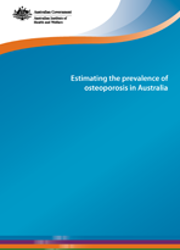Summary
Osteoporosis, a common condition among older people, causes bones to become weak. Until a minimal trauma fracture occurs, osteoporosis has no obvious symptoms and so many cases go undiagnosed. Therefore, it is difficult to determine the true prevalence of the condition (that is, the number of people with the condition).
This report presents information about the prevalence and impact of osteoporosis in Australia using data gathered for Australian men and women aged 50 and over.
No single source of information was found to provide definitive prevalence estimates of osteoporosis in Australia. Collectively, the data show broadly similar patterns of osteoporosis prevalence in the self-reported national surveys and smaller epidemiological studies. The prevalence of osteoporosis increased markedly with increasing age and was higher in women than in men in each age group.
Prevalence of osteoporosis
- In 2011-12 the estimated prevalence of self-reported diagnosed osteoporosis among those aged 50 and over living in the community was 15% of women and 3% of men, according to the Australian Health Survey.
- Based on a recent study measuring bone density in a population sample, the prevalence of osteoporosis among those aged 50 and over was estimated to be 23% of women and 6% of men. This estimate includes both diagnosed and undiagnosed cases of osteoporosis.
- Osteoporosis is listed as a significant health factor affecting the care needs in 12% of people receiving permanent residential aged care. This is likely to be an underestimate because other studies show 21% of people aged over 80 have diagnosed osteoporosis and also due to limitations with the data source for this purpose.
Impact of osteoporosis
- Osteoporosis is one of several risk factors for minimal trauma fracture. While not all minimal trauma fractures occur in people with osteoporosis, fracture risk is higher for those with the condition. Fracture statistics, therefore, provide insight into the impact of osteoporosis and the benefits of its prevention.
- Minimal trauma fractures are relatively common in people aged 50 and over. It is estimated that, for Australians aged 50 and over, 1 in 4 men and 2 in 5 women will experience a minimal trauma fracture in the future.
- Minimal trauma fracture of the hip is one of the most serious outcomes of osteoporosis. In 2011-12, 19,000 people aged 50 and over were hospitalised due to a minimal trauma hip fracture, of whom 71% were aged 80 and over and 72% were women.
- Although the rate of minimal trauma hip fracture for people aged 50 and over has decreased over time (age-adjusted), the actual number of hip fractures continues to increase due to the increasing number of older adults in Australia.
Preliminary material: Acknowledgments; Abbreviations
1 Introduction
- Diagnosing osteoporosis
- Estimating the prevalence of a 'silent' condition
- Risk factors for osteoporosis and minimal trauma fracture
- Questions addressed
- Report structure
2 Diagnosed osteoporosis
- Osteoporosis in the community
- Osteoporosis in residential aged care facilities
3 Measured osteoporosis
- Epidemiological studies measuring BMD
4 The impact of osteoporosis
- Lifetime risk of minimal trauma fracture
- Minimal trauma hip fracture
5 Discussion
- Prevalence of osteoporosis
- Impact of osteoporosis
- Conclusion
Appendixes:
Appendix A: Data sources
Appendix B: Additional table
End matter: References



